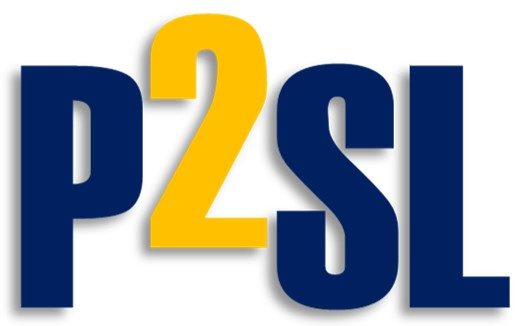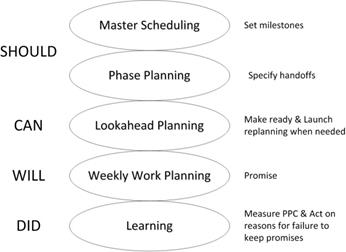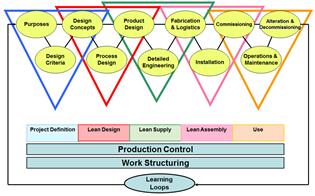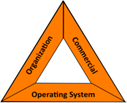L
Language Action Perspective (LAP)
→ see reliable promise
last-in first-out (LIFO)
Inventory management discipline whereby the items that last entered a waiting position (queue) are the first to be withdrawn from there.
→ in contrast with first-in first-out (FIFO)
Last Planner™
The person making commitments on behalf of and assignments to direct workers.
Example: ‘Squad boss’ and ‘discipline lead’ are common names for last planners in design processes. ‘Superintendent’ (if a job is small) or ‘foreman’ are common names for last planners in construction processes.
Last Planner™ System (LPS)
The collaborative, commitment-based planning system that integrates should-can-will-did planning. It includes master scheduling and phase planning to define what SHOULD be done, lookahead planning based on constraints identification and removal (the make-ready process) to establish what CAN be done, weekly work planning based on reliable promises reflecting what WILL be done, and learning based upon analysis of PPC (comparing DID against WILL) and reasons for variance.
Image source: Glenn Ballard
References:
Ballard, G. (1994). The Last Planner. Northern California Construction Institute, Monterey, California.
Ballard, G. (2000). The Last Planner System of Production Control. PhD Dissertation, Univ. of Birmingham, UK, http://www.leanconstruction.org/media/docs/ballard2000-dissertation.pdf
Last Responsible Moment (LRM)
While considering alternatives, the last responsible moment for one alternative is the time at which, if that alternative is not selected and pursued, that alternative is no longer viable.
→ used in Set Based Design (SBD)
Reference: term coined in Lane, R. and Woodman, G. (2000). “Wicked Problems, Righteous Solutions – Back to the Future on Large Complex Projects.” Proceedings 8th Annual Meeting of the International Group for Lean Construction, August 17-19, Brighton, UK.
LCI
→ see Lean Construction Institute
lead time (LT), supplier lead time ∆
[unit of time]
The time it takes a product to go from being ordered to being delivered as input to a production process.
Example: The transformer has a 20 week lead time: it takes 20 weeks to be designed, manufactured, and delivered to our site.
lean
Creating more value for customers with fewer resources.
Reference: Lean Enterprise Institute (2016-04-14) http://www.lean.org/WhatisLean
Lean Construction, Lean Project Delivery
Application of lean thinking to the designing and making (or delivery at large) of capital projects (or projects in general).
→ related Lean Project Delivery System (LPDS)
→ see International Group for Lean Construction (IGLC)
Lean Construction Institute (LCI)
The Lean Construction Institute (LCI) is a non-profit organization, founded in 1997 by Greg Howell and Glenn Ballard to promote lean thinking in the architecture, engineering, and construction industry.
Reference: www.leanconstruction.org
Lean Project Delivery System (LPDS)
Representation of the delivery of a project from determining that which helps clients better achieve their business purposes through final use. Positive iteration is encouraged within each phase so as to prevent negative iteration between the phases. Production control, work structuring, and learning are continuing functions.
Image source: Glenn Ballard
Lean Triangle
Triangle depicting the three domains within which project delivery systems operate:
- The project organization,
- The project’s “operating system,” and
- The commercial terms binding the project participants.
Integrated Project Delivery seeks to systematically attack the deficiencies of “traditional” project management practices observed in each of these domains.
Reference: Thomsen, C., Darrington, J., Dunne, D., and Lichtig, W. (no date). Managing Integrated Project Delivery. CMAA, McLean, VA, 104 pp.
learning
The process of gaining new knowledge or insights whose implementation may improve product and process development.
Learning can stem from experimentation (using PDCA) or breakdowns.
least preferred alternative [CBA]
→ see advantage
LIFO
→ see last-in first-out
line-of-balance diagram, location-based management system (LBMS), location-based schedule, repetitive scheduling method, velocity chart
Two-dimensional representation of a schedule broken down by units of work (e.g., repetitive spatial units such as floors, rooms, or road sections in-between stations) using a line for each activity, so as to depict the continuous application of resource(s). The horizontal axis may represent time and the vertical axis the unit of work (or space), or the axes may be flipped.
Reference: Harris, R.G. and Ioannou, P.G. (1998). “Scheduling projects with repeating activities.” Journal of Construction Engineering and Management, ASCE, 124 (4) 269-278.
Little’s Law ∆
WIP = TH * CT
where
WIP is Work-in-Process [unit of work]
TH is Throughput [unit of work/unit of time]
CT is Cycle Time [unit of time]
Example: A builder uses even-flow production: they start (and finish) about 3.2 houses each month. It takes them about 14 weeks (the cycle time) to complete each house. Using Little’s Law you can thus compute that have about 11 houses under construction at any one time.
Given: TH = 3.2 houses/month
CT = 14 weeks * (1 month)/(4 weeks) = 3.5 months
Compute: WIP = 3.2 houses/month * 3.5 months = 11 houses
References:
Wardell, C. (2003). “Build by numbers.” Builder Magazine, January 1, pp. 1-6.
Also see Hopp, W.J. and Spearman, M.L. (2000). Factory Physics. 2nd ed., McGraw-Hill, New York, NY, 698 pp.
load
The amount of output expected from a production unit or individual worker within a given time. Within a weekly work plan, what is to be accomplished by a design squad or individual designer, engineer, draftsperson, construction craft worker, crew, etc.
A quality assignment “loads” a resource within its capacity.
load leveling, demand leveling, heijunka, production leveling
An approach to smooth production flow when a mix of products is to be produced, by identifying for a selected time period, the smallest batch size at which to produce each specific product in the mix, before switching over to make another product in the mix.
The goal is to increase the regularity by which products of different types are produced, countering the tendency to batch in reaction to frequent change-over times, even though customer demand may be irregular. This practice creates the need to focus on reducing setup and changeover times. The resulting flexibility enables the production system to cope with varying demand and market fluctuations without incurring additional production cost for such customization.
Note that in project production, demand can be leveled by means of work structuring (including planning). We shape—if not create—our own demand.
Example: customer demand for AAAABBAAAACC gets leveled to ABAACAABAACA.
→ related to SMED
location-based management, location-based management system (LBMS)
Scheduling repetitive units of work based on the line-of-balance method. This includes representing the schedule with time on one axis and units of space (locations) on the other axis, and the use of time buffers to accommodate variation.
Reference: Kenley, R. and Seppanen, O. (2010). Location Based Management for Construction: Planning, Scheduling, and Control. Spon Press.
long lead materials
Materials that take a long time to specify and acquire, so that typically they cannot be pulled to site within the lookahead window.
In the extreme, some materials must be procured even before the project starts; without them, there is no project.
Example: The CII report on PEpC (Procure, Engineer, procure, Construct) distinguishes the big-ticket items that must be Procured (uppercase P) up-front (e.g., a turbine-generator for a power plant), from smaller items that can be procured after engineering (lowercase p).
Reference:
lookahead
→ see make ready
lookahead planning, lookahead scheduling
→ see make-ready planning
lookahead window
How far ahead of scheduled start activities in the master- or phase plan are subjected to explosion, screening, or make ready. For example, lookahead windows may extend from 3 to 12 weeks into the future.
The duration of the lookahead window is defined in function of the ability to pull material to site (to obtain what is needed when it is needed, aka. to make ready). This duration depends on your ability to predict in advance at the task level what work needs to be done in the future. When there is a lot of uncertainty in the system, you may not be able to break down work to the task level.
LRM
→ see Last Responsible Moment



